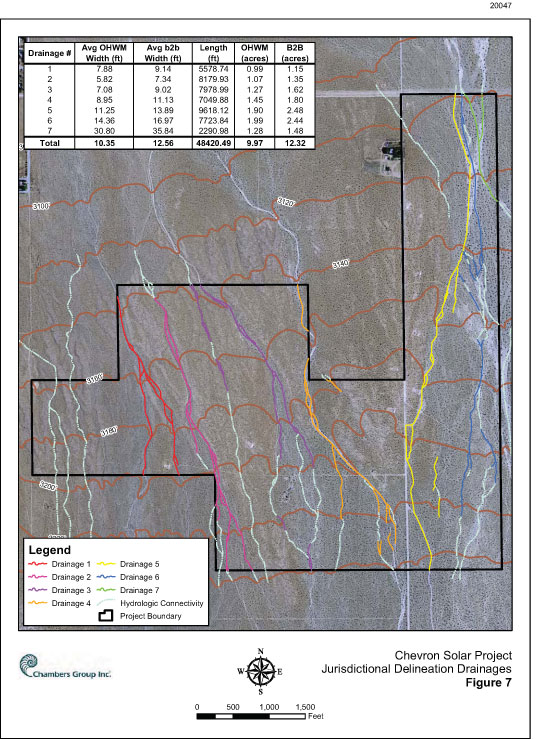Update: Project Pending
March 10, 2014 - Celtic Energy Corporation has filed an application for a solar project. This project, Lucerne Valley Solar, is a 45 MW alternating current solar photovoltaic power plant proposal located approximately one-half mile south of State Highway 247, and approximately three miles east of Camp Rock Road. The project is also generally seven miles east and southeast of the community of Lucerne in San Bernardino County CA. A Final Environmental Impact Statement and Record of Decision were initially issued on October 5, 2010 for the project. The Project footprint would cover 421 acres of public lands administered by BLM.
Contacts: Cedric Perry, Project Manager, RECO California Desert District Office
Status: Refresh surveys have been completed by the applicant and approved by the Bureau of Land Management. The California Fish and Wildlife has requested a gap analysis to be conducted to determine if the 2010 EIS fulfills the requirements of the CEQA document. Submission of funds for the project cost recovery account is pending.
Project Approved by Salazar
October 5, 2010 - At 11:00 AM this morning, Interior Secretary Ken Salazar, overseeing the Bureau of Land Management land where the proposed Imperial Valley Solar Project and Chevron Lucerne Valley Solar Project are located, signed the final Record of Decision approval along with California Governor Arnold Schwarzenegger.
The Chevron Lucerne Valley Solar Project was stated to be on "disturbed lands," but site visits revealed that the place is a thriving old-growth Mojave Desert creosote scrubland with Joshua tree woodland, and a high density of the Federally Threatened Desert tortoise.
Both projects will also lower the quality of life for rural residents, and eliminate all recreational opportunities on public land as chain-link fences go up around the solar projects.
“Our collaborative approach shows how separate government processes can be streamlined, without cutting any corners or skipping any environmental checks and balances in the process,” Salazar said. “I commend Governor Schwarzenegger and the people of California for their leadership and partnership on these important renewable energy projects."
We disagree, and maintain that environmental and cultural reviews were cut short in the Fast-tracking process, eliminating the public from much participation. Also eliminated was a fair and realistic assessment of Alternatives such as Distributed Generation. Especially glaring are the hundreds of acres of photovoltaic panels that will be placed on a desert ecosystem in Lucerne Valley, panels that can more easily and quickly go on rooftops in the built environment. Renewable energy projects are important, but they need to go in the right place, on rooftops, not on pristine deserts in public land.
http://www.whitehouse.gov/blog/2010/10/05/first-large-scale-solar-energy-plants-public-lands
This Land Is Not Disturbed
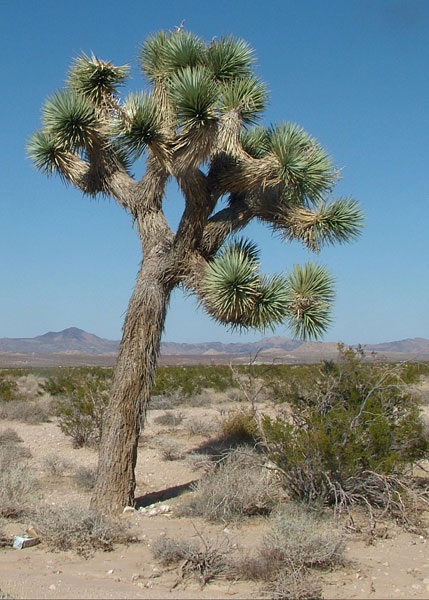
<Mature Joshua Tree. View is toward historic Old Woman Springs Rd. (Hwy 247). The Joshua Tree may be hundreds of years old. The creosote bushes may be thousands of years old. Less than 5 miles from this site is the "The King Clone" creosote circle, 9000+ years old, called the oldest living organism. It is in much the same kind of terrain. Is there an undiscovered creosote ring even older somewhere on the Chevron site? Has anybody looked for one? (Photo by Betty Munson).
Lucerne Valley, California - On a beautiful Joshua tree creosote alluvial fan in the Mojave Desert, with a relatively high number of Desert tortoises, Chevron Energy Solutions is proposing to develop a 45-megawatt solar photovoltaic plant and associated facilities on 516 acres of federal land managed by the Bureau of Land Management (BLM), 8 miles east of Lucerne Valley in San Bernardino County.
It is an ill-conceived Fast-tracked project that many have been led to believe is on "disturbed land," a term that is becoming of dubious value when applied to so many desert habitats that when ground-truthed are found to be healthy, functioning ecosystems.
That people live near here should not lessen the value of this desert, as it is home to an above average number of tortoises per acre when looking at all the desert solar projects.
In addition, the rural quality of life in Lucerne Valley is becoming threatened along with the tortoise, in the push for large-scale renewable energy industries that ignore neighbors and community goals.
Also included in the proposal is an interconnection to an existing Southern California Edison distribution line located north of the site. In addition, CES’s proposal includes an amendment to the California Desert Conservation Area (CDCA) Plan that would designate the proposed site as suitable for solar energy generation. The project would also reroute a portion of Zircon Road to allow its continued public use.
The proposed project would be built in two phases. Phase I would be 20 MW, with construction beginning in late 2010. It would interconnect to the existing Southern California Edison (SCE) 33 kilovolt (kV) transmission line located immediately north of the site across Foothill Road and could be built without upgrading the existing line. Phase II would be contingent upon available transmission capacity and future power sales. Phase II would occur after this is completed. By doing it in stages, Chevron knows it has a higher probability of getting approval for at least part of the project through avoiding the transmission issue. But then getting approval for the second stage will be easier, despite the transmission hurdle, and more desert will be scraped.
The major components of the Lucerne Valley Solar Project would consist of the following:
A switchyard for meeting interconnection control, and metering requirements; Operations and Maintenance Building; Parking/laydown area; Access roads within the right-of-way; 2-mile overhead 33-kV collector system, and the Solar array.
Bureau of Land Management website
Headlines Promote the Project, Community Does Not
August 31, 2010 - NEARBY LUCERNE VALLEY SOLAR PROJECT TO COVER 516 ACRES
A new solar field in nearby Lucerne Valley will cover 516 acres with solar panels. In this feature story, Z107-7 Managing Editor Karl Gardner says the project tries to balance the need for power with environmental concerns... California’s recent heat wave reminds many of the power of the sun. Conservationists say a planned solar project in the Mojave Desert promises to harness that power in a way that protects wildlife and plants. Kim Delfino with Defenders of Wildlife says the Lucerne Valley Solar Project is “smart from the start. “They’ve placed it on lands that have lower biological values. It’s in Lucerne Valley and therefore it’s close to the load source that they need for the energy and it’s near existing transmission lines.” Delfino says as the state moves forward with the development of more solar plants it’s vital that the fragile desert landscape and dwindling water supplies be protected. She says once a desert is degraded, it takes millions of years to regenerate. The Lucerne Valley project recently cleared its final environmental review. The 516-acre solar energy power plant is expected to break ground later this year and begin providing power to almost 20-thousand California homes in 2011. Delfino says its’ important that solar plants are developed in a sustainable way and that past mistakes from oil drilling and mining are not repeated. “Instead of just allowing projects to sort of pop up wherever the developers happen to put them, we really need to be taking a proactive approach – planning where development should be occurring, identifying those low-value degraded lands and directing the development there.”
From Z107.7 Local News Community Radio - Listen >>here (956 KB MP3 file)
Headline: "Lucerne Valley Solar Project to power 20,000 homes" (Inaccurate Statement, See below) - Why Not Put This on 20,000 Rooftops?
July 18, 2010 - San Bernardino, California - The Lucerne Valley Solar Project cleared its final environmental review this week and, according to the project's developers, will generate enough clean, reliable and renewable electricity to power almost 20,000 California homes. The project has the support of conservation groups working in California and nationally because it demonstrates that large-scale solar energy projects can be planned in a way that protects plants, wildlife and other desert resources.
"The Lucerne Valley Solar Project is a great example of a project that's smart from the start," said Johanna Wald, senior attorney at the Natural Resources Defense Council. "We need clean energy, but we also need to protect our diverse wildlife, unique wildlands, and dwindling water supplies. The Lucerne Valley Project achieves the balance between meeting our clean energy needs and protecting our sensitive public lands ecosystem."
The U.S. Bureau of Land Management issued a Final Environmental Impact Statement for the Lucerne Valley Project last week. Located east of Victorville in the southern California desert, the 516-acre solar energy power plant is expected to break ground later this year and begin powering California homes in 2011.
"It makes sense to start with careful planning up front, so that we can have both clean energy and a healthy environment for generations to come," said Alice Bond, California public lands policy analyst. "While the Department of the Interior works to finalize its regulations on how and where solar projects are built on public lands, companies that focus on the right places and the right technology to reduce conflicts from the get-go will continue to find success."
The Wilderness Society, Defenders of Wildlife, Natural Resources Defense Council and Sierra Club are working closely with wind and solar developers, community groups, and local, state and federal agencies in California and across the West to promote "smart from the start" renewable energy planning that will help America tap into its vast renewable energy potential, while protecting important wildlife habitat, water resources and desert vistas. Lucerne Valley fits the bill because it has high solar potential, is close to existing roads, infrastructure and transmission lines, and avoids sensitive areas that have been identified as of critical for wildlife and other vital natural resources.
"We can't afford to make the same mistakes with wind and solar energy that were made -- and are still being made -- with coal mining and oil and gas drilling," said Kim Delfino, California Program Director at Defenders of Wildlife. "We need to be smart from the start so that Lucerne Valley and projects like it will help America break its dependence on dirty energy sources."
"It's important to steer renewable energy projects away from high value, intact desert habitat, and the Lucerne solar project developers are to be commended for siting it in an already fragmented area," said Joan Taylor, Chair of Sierra Club's California/Nevada Desert Energy Committee. (From The Wilderness Society).
The Community Disagrees
REBUTTAL
Jim Harvey, President of the Homestead Valley Community Council and founder of Alliance for Responsible Energy Policy, explained to us that the claims made by Wald are wrong, namely that 45 MW divided by the 20,000 homes will be served by the project after full buildout is 2.5 KW capacity per home. "Since the sun they will be using to power their project is the same sun a home could use for a Point-of-Use system, then under Wald's calculations, we can zero out 20,000 homes with a small 2.5 KW system, right? Wrong. The average home requires about 4 KW of PV capacity to meet full energy needs, making the 'homes served' total far less... It would be closer to 10,000 homes." Harvey wonders what other numbers are wrong, the number of tortoises? The cost of the project and its electricity generated? The number of jobs?
"Chevron has refused to discuss the cost of this project, because they know 45 MW of PV solar is WAY cheaper when implemented in a building integrated/rooftop, point-of-use, consumer owned model." Utilities, heavily-lobbed lawmakers, and certain environmental groups have colluded to prevent this consumer-owned model from happening.
"They get their devastating projects approved, and we get higher energy bills, lower property values from lost open spaces, increased dependence on further congested transmission lines, increased demand for new transmission lines (RETI), no job creation..., and a reason for other Big Energy developers like Chevron to come into our rural communities and keep the bulldozers busy.
"In the meantime, Germany installs TEN times the PV solar than CA, 90% of which is building integrated/rooftop, with half our solar resources, with only modest energy bill increases to non-participants."
RESOLUTION
Letter from Betty Munson of the Homestead Valley Community Council, and Resolution by Jim Harvey, President of the HVCC:
Attached is a [383 kB] .pdf file of the resolution from the Homestead Valley Community Council, protesting the CHEVRON LUCERNE VALLEY SOLAR PROJECT.
(The HVCC is an organization established by the four Homestead Valley communities and represents them to local, county, state and federal officials when issues arise that concern the well-being of the area.)
Also attached are four images of the area proposed for the Chevron solar fields, and the audio file of the Z107.7FM broadcast of September 9.
I am astounded at the support this project has received from so-called environmentalists, including The Wilderness Society, Defenders of Wildlife, the Natural Resources Defense Council and the Sierra Club.
They have characterized this proposed installation of industrial-scale solar generation as "smart from the start" and of low wildlife and scenic values.
Who gets to decide on wildlife and scenic values? This is thriving Mojave Desert. Are all public lands in the Mojave Desert this vulnerable to destruction?
“It’s important to steer renewable energy projects away from high value, intact desert habitat, and the Lucerne solar project developers are to be commended for siting it in an already fragmented area,” said Joan Taylor, Chair of Sierra Club’s California/Nevada Desert Energy Committee.
I fail to see the fragmentation here. In the 516 acres there are a couple of old homesteads fallen down and eight or so prospect diggings. This has not interrupted the ancient course of life here.
I also fail to see ANY wildlife or scenic values in ANY solar field.
Pictures 1-3 were taken on the Chevron site by me on Labor Day 2010.
1. Mature Joshua Tree (see top of page). View is toward historic Old Woman Springs Rd. (Hwy 247). The Joshua Tree may be hundreds of years old. The creosote bushes may be thousands of years old. Less than 5 miles from this site is the "The King Clone" creosote circle, 9000+ years old, called the oldest living organism. It is in much the same kind of terrain. Is there an undiscovered creosote ring even older somewhere on the Chevron site? Has anybody looked for one?
2. Large Wash (below). View is toward Lucerne Dry Lake. The numerous washes on the site must be filled, the drainage diverted then returned to its ancient channels. These photos taken after a very hot summer, but the multitude of creosote bushes are thriving, though annual wildflowers and perennial shrubs have gone to seed.
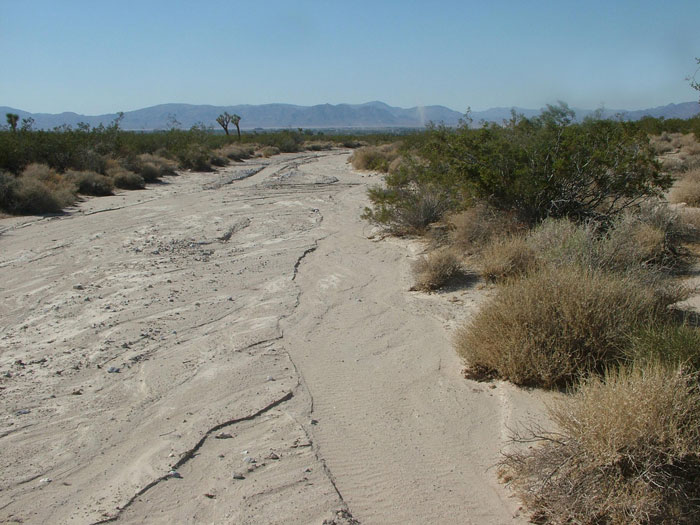
3. (Below), wash with evidence of the recent heavy rain (the August 26th flash flooding was two miles to the west). The ridge in the middle distance is one side of the prehistoric Blackhawk landslide, a geological wonder. San Bernardino Mountains in the background.
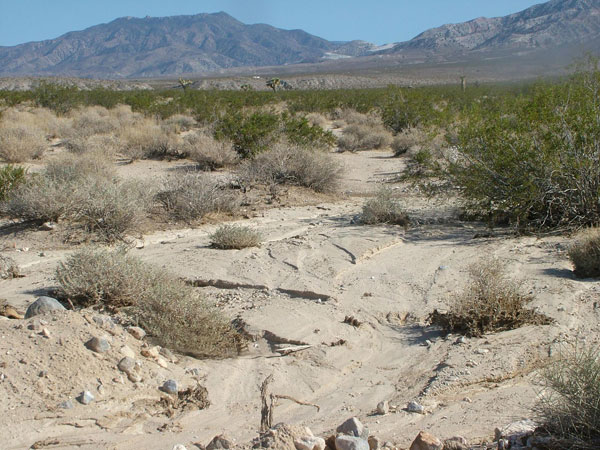
4. Cover of the Draft Environmental Impact Statement (below). This photo also contradicts the claim the area is of low scenic and wildlife value.

Betty Munson,
Secretary HVCC
------------------------------------------------------------------------------------------------------
Betty Munson also told us: "Let's start with some rooftops and abandoned shopping malls first, Or an abandoned golf course in Yucca Valley. OK?"
What about the claim that the site has low wildlife and scenic values? "SAYS WHO? What is the criterion for wildlife and scenic values? This place is pretty, if not spectacular, in a typical rural desert setting, with the mountain backdrop, the amazing Blackhawk prehistoric landslide just to the east. The photos Chevron put into their impact statement looked scenic to me. The solar fields I see have NO wildlife and scenic values."
Or the claim that t contains no designated critical habitat for listed species and no special management areas? "Who gets to do the designations and listings? I designate it as desert habitat, period. Thousands of healthy thriving creosote bushes and other shrubs sucking in CO2, pumping out O2, all without costing me a penny in taxes."
BLM says that the site, though it is undeveloped, contains some disturbed land. It supports several old buildings, as well as graded roads. Mineral exploration has been conducted on the parcel. "Traces of flood damage count as disturbed land, not all disturbances are by humans. Santa Fe Fire Trail Road also counts as a disturbance. We better get out there and see those old buildings (which I have not seen mentioned before) and the mineral exploration (what, 100-yr-old prospecting coyote holes?) Anything over 50 years is HISTORICAL. Obviously, the wildlife have successfully coexisted with these disturbances for some time.
It is relatively close to an urbanized area. "Many sites of scenic and historic value are close to urbanized areas. And what is 'relatively'????"
BLM also states, With or without the solar project, this land has been approved for some kind of intensive use. "WELL, I DISAPPROVE. And so do a lot of other people...who live here! If these public lands are ever given over to some kind of intensive use, I would only approve of it if that use would be of very substantial benefit to the people who live 'relatively' close by. The solar project does not meet that criterion."
Community Files Protest
LUCERNE VALLEY ECONOMIC DEVELOPMENT ASSOCIATION (LVEDA)
To: Brenda Williams – Director (210) - via e-mail and regular mail
Bureau of Land Management
P. O. Box 66538
Washington, DC 20035
Cc: Roxie Trost – Barstow BLM Field Mgr.
Mickey Quillman, Barstow BLM Chief of Resources
Greg Thomsen – BLM
Re: PROTEST – Power Purchase Agreement/Final Environmental Impact Statement - Chevron Energy Solutions – Lucerne Valley Solar
From: LVEDA
Date: 9/9/10
LVEDA’s Mission Statement:
Provide a forum for discussion and action on important community issues – promote infrastructure improvements – work with County and developers to promote development that is both “economic” and compatible with our rural lifestyle, environment and resource availability.
BLM’s approval of the PPA in and by itself is inconsistent with our mission statement – in turn leading to approval of the Chevron Solar Project that is not economically beneficial to our community and will result in direct and cumulative impacts.
Since only the CDCA Plan Amendment approval can be “protested” – not the right-of-way grant – LVEDA’s protest inherently references the PPA. It’s obviously difficult to separate project issues from the PPA – which enables the project.
We ask BLM to do some serious “soul searching”! The Chevron Solar project does not warrant a CDCA Plan Amendment – especially since this project was not vetted via the so-called “Programmatic” process. The CDCA’s intent was to keep the “whole of the Calif. Desert” intact – not parcel it out bit by bit in reaction to each and every project application – diluting its land-use integrity.
BLM’s responses to our comments in the FEIS (most likely drafted by EIS preparer Ecology and Environment, Inc.) are predominantly the typical “boiler plate” – kick the can down the road” statements that don’t adequately deal with on the ground reality of a Plan Amendment approval.
Some of our previously submitted comments on the DEIS are listed below. Following them (in BOLD CAPs) are our protest points on the BLM responses contained in the FEIS:
LVEDA provides an “open forum” dealing with major projects and issues affecting/benefiting Lucerne Valley. We are in general opposition to utility-scale solar projects – especially on public land – preferring the use of pre-disturbed/fallowed private land – but as a first priority – solar panels on rooftops/parking lots/etc. throughout s. Calif. (which the DEIS failed to analyze as a viable alternative to the further commitment of public land resources to subsidize urban areas). AN IN-DEPTH ANALYSIS OF VIABLE ALTERNATIVES TO THE USE OF BLM - ADMINISTERED PUBLIC LAND IS NOT “BEYOND THE SCOPE” OF A VALID NEPA DOCUMENT. THE “REASONS DETAILED IN SECTION 2.3.1.OF THE DEIS” ARE NOT SUFFICIENT TO JUST GLOSS OVER ALTERNTIVES.
We question the intent of a large corporation or its affiliates going through all the time, expense, permitting, paperwork, mitigation, etc. for a (relatively minor) 45 MW project. If it’s a “feel good – we’re doing something ‘green’ endeavor” – we prefer that the applicant partner with SCE and spread out its “good will” on rooftops and parking lots – a bigger public relations benefit. WE CERTAINLY HOPE THAT THIS “WILL BE TAKEN INTO ACCOUNT BY THE AUTHORIZED OFFICER”.
Before the final decision is made, this project should be assessed via BLM’s Programmatic process which will identify the limited areas available and suitable for solar plants – along with an understanding of all the land-uses that Lucerne Valley already provide s. Calif. - to fully understand current conflicts and why we need an "Energy Element" in our current BLM and County Plans. THE FACT THAT “…THIS APPLICATION WILL BE FULLY PROCESSED PRIOR TO A PROGRAMMATIC SOLAR EIS BEING COMPLETED IN CALIFORNIA” IS THE PROBLEM. THE HORSE NEEDS TO BE IN FRONT OF THE CART!
Alternative 4 – Modified Site Layout – a viable option - would allow a buffer and on-site location and maintenance of transplanted yuccas/joshua trees – more reliable than “availability off-site to the public” – which would likely result in 50% mortality at best. “WORKING WITH SB COUNTY TO DEVELOP A SALVAGE PLAN” DOESN’T INDICATE WHETHER OR NOT THE “MODIFIED SITE LAYOUT” ALTERNATIVE WAS INCORPORATED INTO THE PROJECT. WAS IT?
The “private land” alternative was basically ignored with inadequate rationale. First Solar and Next-Era found large, fallowed parcels in Lucerne Valley – with a lot more existing all the way to Palmdale. THE RESPONSE THAT “THIS ALTERNATIVE IS OUTSIDE THE SCOPE OF THIS EIS” IS COUNTER TO NEPA AND COMMON SENSE OBJECTIVES TO FIND THE BEST PLACES FOR THESE RENEWABLES. MORE IMPORTANTLY – IT JUST REVEALS THAT BLM (PUBLIC) LAND IS THE CHEAPEST AND EASIEST OPTION!
Rated generating capacity vs. actual production is a major issue with desert solar projects. The net benefit is likely marginal. Energy/CO2 emissions/etc. required for making panels, structures, construction, etc. – plus the consumption of 516 acres of public land (@11 ½ acres/MW) – plus the additional loss of “multiple use” on the mitigation/compensation land ----compared to other energy sources – need to be assessed from a more global perspective. IF “THE PURPOSE OF THE NEPA PROCESS IS TO WEIGHT THE VARYING BENEFITS AND LOSSES FOR PROPOSED PROJECTS” – THE FEIS NEEDS A MORE QUANTIFIABLE COST/BENEFIT ANALYSIS.
De-brushing/grading will create a long-term dust source, adversely affecting the facility and down-wind receptors. Minimal grading, vegetation mowing and placement of decomposed granite or small gravel will help to stabilize the site and reduce weed infestations – as well as enhancing native re-vegetation if and when facilities are removed. However, the perennially-shaded ground will become devoid of vegetation and root structure – and the partially shaded area will likely generate more weeds than natives – thus a hindrance to operations and the need for regular weed abatement. PER THE RESPONSE: “THE ENTIRE SITE WOULD BE ROUGH GRADED” - WHICH REALLY MEANS “GRADED”- THEREFORE A PROJECT REALITY AND CONSEQUENCE OF PPA APPROVAL THAT SHOULD HAVE BEEN DIVULGED AT THE ONSET.
Construction water might be obtainable from the Mojave Water Agency’s “Morongo Pipeline” – generally following Foothill Rd. immediately north of the project site – the use of untreated state water vs. good quality groundwater. Contact: MWA (760 946 7000) for info. and location of connections. THE FACT THAT “CES IS AWARE OF THIS SOURCE OF WATER AND MAY CONSIDER IT AS A RESOURCE” LEAVES UNRESOLVED ANY ALTERNATIVE SOURCES THAT MIGHT HAVE TO BE UTILIZED – WITH IMPACTS NOT DIRECTLY ASSESSED IN THE FEIS.
3.11-3: The statement: “Hunting is not an allowable use on the Proposed Action site” is very likely incorrect. It certainly won’t be when construction starts – but currently – the only regulation we know of is “shotgun only”. APPRECIATE THE CORRECTION IN THE FEIS.
To fully assess the consequence of the project’s effect on biological resources – the DEIS needs a description of the most likely location for the 1:1 ratio mitigation/compensation – the location and ultimate loss of “multiple uses” on said parcel that might be purchased – or to what resource any “in-lieu” fee might be directed. Off-site mitigation/compensation requirements ARE a direct result of this project and need to be fully explained. FUTURE ADHERENCE TO THE “NEW RENEWABLE ENERGY MITIGATION POLICY” WHICH “DOES NOT HAVE SPECIFIC INFORMATION REGARDING FUTURE ENHANCEMENT PROJECTS OR ACQUISITION” - DOESN’T TELL US WHERE AND HOW THIS PROJECT WILL BE MITIGATED/COMPENSATED – A DIRECT CONSEQUENCE OF THIS PROJECT NOT DIVULGED – RELIANCE ON A FUTURE “SEPARATE NEPA DOCUMENT” - JUST BETTING ON THE COME – KICKING THE CAN DOWN THE ROAD AGAIN.
Assuming the applicant fully intends to develop both phases, approval of Phase 1 alone is premature w/o knowing the transmission requirements of both phases together (upgrading existing line or a new one). Needs discussion! THE RESPONSE ADMITS THAT THIS IS NOT RESOLVED – CERTAINLY NOT IN COMPLIANCE WITH “THE WHOLE OF THE ACTION” CONCEPT – YET A DIRECT CONSEQUENCE AND IMPACT RESULTING FROM THE PLAN AMENDMENT AND PROJECT APPROVALS.
New transmission lines or upgrades should include “raven proof” devices to the extent feasible – ravens being the biggest threat to juvenile tortoises. THE RAVEN MANAGEMENT PLAN WOULD NEED TO BE FULLY IMPLEMENTED – NOT FILED ON A SHELF LIKE SO MANY OTHERS.
The “heat sink” and albedo “change” effects need to be assessed, especially for the larger projects and those close to residential uses. JUST BECAUSE THE PROJECT IS “NOT CLOSE TO A RESIDENTIAL AREA” (BUT IS CLOSE TO RESIDENCES!) – NO EXCUSE TO SHINE IT ON. LOCALIZED HEAT SINKS CAN AFFECT MICRO ENVIRONMENTS. THE SIGNIFICANCE, IF ANY, NEEDS TO BE QUANTIFIED.
The “level of service” (LOS) assessments for regional highways/roads don’t adequately quantify the actual “on the road” impacts – especially on Hwy 18 through Lucerne Valley’s commercial area and 4 way stop. CHP escorting will likely be necessary. The proposed “off-peak” construction travel may not fully suffice in and by itself. IMPLEMENTING TRAFFIC BMPs WON’T SOLVE THE 4-WAY STOP PROBLEM – WITH MULTIPLE TRUCK TRIPS FROM AND THROUGH LUCERNE VALLEY DURING OFF-PEAK HOURS - WHICH WASN’T DIRECTLY ASSESSED. FEDERAL AND STATE APPROVED PROJECTS NOTORIOUSLY NEGLECT LOCAL COMMUNITY INFRASTRUCTURE REQUIREMENTS AND LIMITATIONS.
Unless we missed it – there was no mention of a right-turn lane onto Santa Fe Fire Rd. Quote from our scoping letter: “A right-turn lane on Hwy 247 would provide safer egress in this area of high-speed traffic – especially for the construction phase”. INSTEAD OF “MAY CONSIDER DEVELOPING A TEMPORARY RIGHT TURN LANE FOR USE DURING CONSTRUCTION” – IT SHOULD BE A REQUIREMENT - AND LEFT IN PLACE FOR PROJECT MAINTENANCE AND RESIDENTIAL USE.
The analysis re: the project’s future effect on BLM’s CDCA Plan’s “Contingent Corridor S” is probably correct – but this “corridor” needs to be removed from the Plan in order to preclude another “Green Path North” attempt. IF BLM APPROVES THIS PLAN AMENDMENT OVER OUR OPPOSITION – THE LEAST IT CAN DO FOR LUCERNE VALLEY IS ELIMINATE THIS CONTINGENT CORRIDOR FROM THE CDCA PLAN.
4.6-5: Question: The project description seems to indicate that the panels would be “fixed” in place – thus w/o tracking ability. If so – is this statement correct?: “During precipitation events, solar panels would be placed in the flat horizontal position”. SINCE “BOTH FIXED TILT AND SINGLE AXIS TRACKER SYSTEMS ARE POSSIBLE, BUT A FINAL DECISION HAS NOT BEEN MADE” – THE NET ENERGY CONSUMPTION VS. OUTPUT FROM THE TWO SYSTEMS SHOULD BE DESCRIBED.
Figure 3.18-1: The Cumulative Projects Map shows a “Cumulative Effects Study Area” (CESA) boundary within a 6 mile “buffer” radius from the project site. However it shows other proposed project locations outside said “buffer”. A complete and adequate cumulative impact analysis needs to show and assess all the proposed projects within the larger Lucerne Valley area that is affected. Some of the renewable projects listed may no longer be considered. The ones not shown – all with applications currently being processed by the County and/or BLM – are 2 “First Solar” PV’s west on Hwy 18 and another adjacent to Barstow Rd. – Granite Wind west of Barstow Rd. (with DEIR/EIS issued) – Next-Era’s PV in n. Lucerne Valley – plus the proposed 29 Palms Marine Base expansion into a major portion of Lucerne/Johnson Valleys northeast of the Chevron site. All these projects will have significant cumulative effects on our community. THE RESPONSE DOESN’T DEAL WITH THE REAL ISSUES. EVEN THE INTERNATIONAL BROTHERHOOD OF ELECTRICAL WORKERS - LOCAL 477 - HAS A BETTER UNDERSTANDING OF THE IMPLICATIONS THAN THE FEIS AUTHORS!
4.15-3: The statement: With the project, “the social well-being of LVEDA (and its reps.) would be enhanced because compatible sustainable infrastructure development would be implemented within the Lucerne Valley” is a bit esoteric and certainly not fully consistent with our mission. Some of the residents close to the project site remain opposed and thus seem to be “adversely affected” by the project. THE RESPONSE - “THE ANALYSIS IS BASED ON THE ECONOMIC DEVELOPMENT AND FINANCIAL STIMULUS TO THE AREA” BEGS THE QUESTION – WHAT “ECONOMIC DEVELOPMENT” OR REAL LONG-TERM “STIMULUS”? NOTHING CONVINCING TO THAT EFFECT IS IN THE FEIS.
Need more emphasis on “local hiring”. Talent and equipment are locally available for a substantial portion of the construction and maintenance work required. It certainly won’t look good to import a lot of outside workers – union or not – when a local workforce is available. Would be just another imposition on our community. Cement/concrete/aggregate are locally available and we certainly expect that they be utilized if the project is built. JUST HOW WILL THIS “BE TAKEN INTO ACCOUNT BY THE AUTHORIZED OFFICER”? BLM IS IN NO POSITION TO TELL CONTRACTORS WHO OR WHERE TO HIRE. THIS CAN ONLY BE IMPLEMENTED BY THE PROJECT DEVELOPER.
The project’s effect on surrounding private land values is summarily dismissed. At the very least, it could hinder area sales. Empirical data is insufficient to determine “no substantial effect”. RELIANCE ON MODELS DOESN’T ALWAYS REFLECT REALITY – ESPECIALLY THE LOST OPPORTUNITIES FOR SALES DUE TO PROXIMITY TO CERTAIN LAND-USES. THERE IS ENOUGH PRIVATE LAND WITHIN THE LOCAL AREA THAT COULD BE ADVERSELY AFFECTED.
These projects aren’t necessarily “beneficial” to local communities. We need ways to make them more “friendly and welcomed”. Chevron could be the lead in devising a method to “arrange” the purchase of materials in San Bernardino County – with sales tax benefiting the county – and ideally – the ½ cent Measure I (road tax) portion dedicated to Lucerne Valley roads that get hammered by all the truck traffic associated with these projects. THIS NEEDS TO BE “TAKEN INTO ACCOUNT” BY THE APPLICANT – NOT JUST THE “AUTHORIZED OFFICER”. JUST TELL US WHETHER YOU ARE WILLING TO DO IT OR NOT!
We invite the applicant to a LVEDA meeting to better explain the project’s tax revenue benefit – specifically the annual taxes from its “leasehold interest”. Property taxes are not generated from public lands. How do these projects’ tax incentives affect property tax revenue normally based on the assessed values of the facilities? Would the annual “leasehold interest” revenue be deducted from what the county receives from BLM as “payment in lieu of taxes” (PILT)? CES DID “ATTEND A MEETING WITH LVEDA IN AUGUST 2010” – CERTAINLY APPRECIATED – BUT THESE “REVENUE” QUESTIONS WERE NOT FULLY ANSWERED – STILL WAITING RESPONSES.
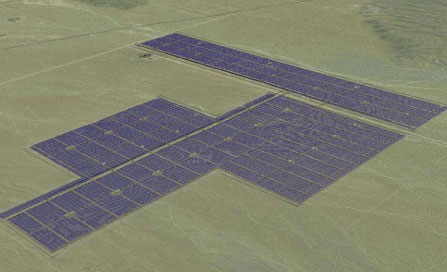
^Digital image of how the project would look (Photo from BLM FEIS).
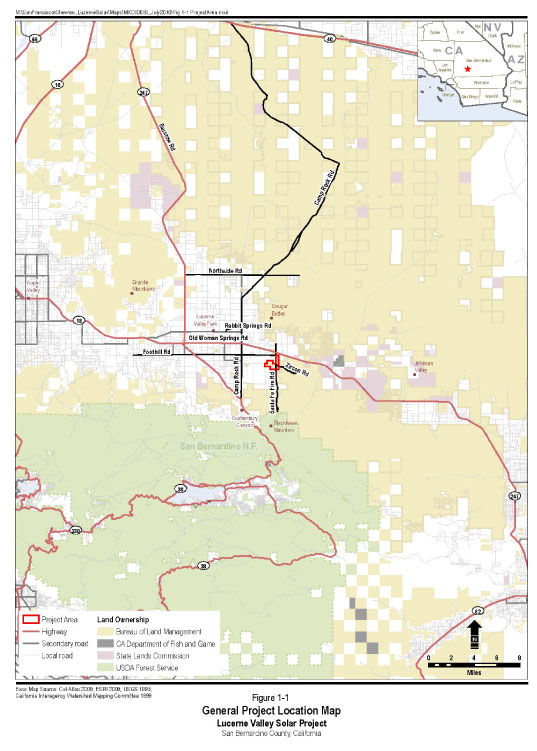
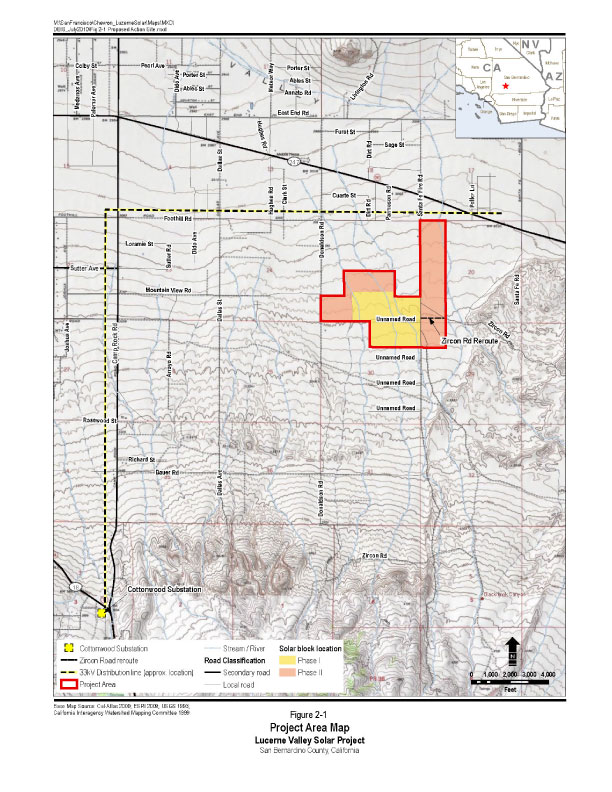
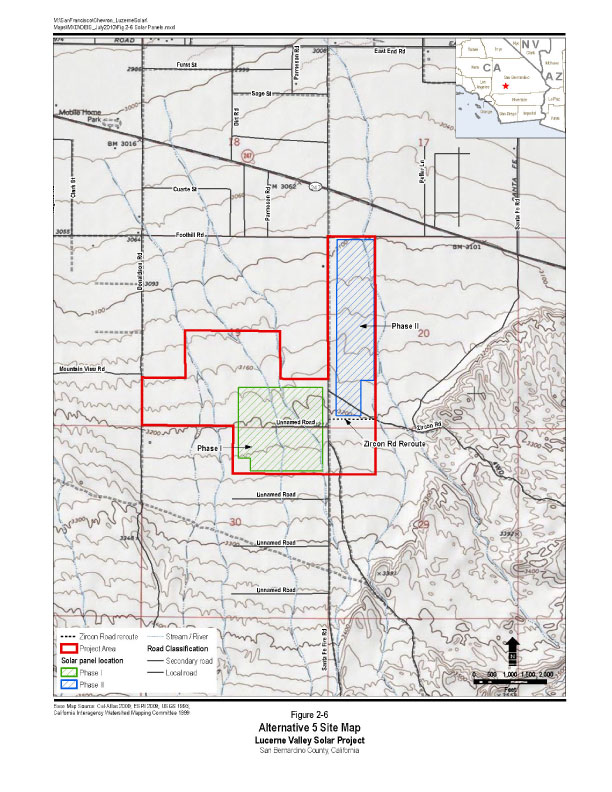
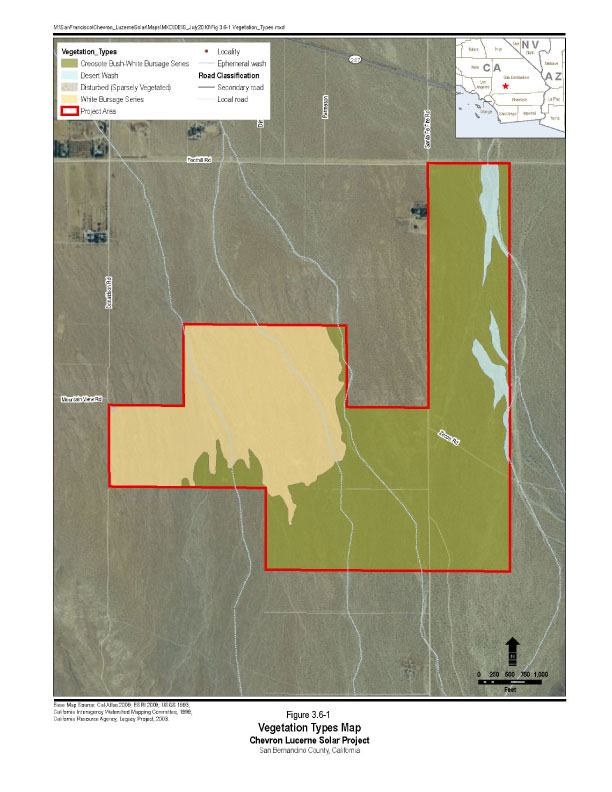
^Vegetation communities: cream color is White bursage (Ambrosia dumosa); green is Creosote (Larrea tridentata)-bursage; blue is wash habitat. Is this disturbed?
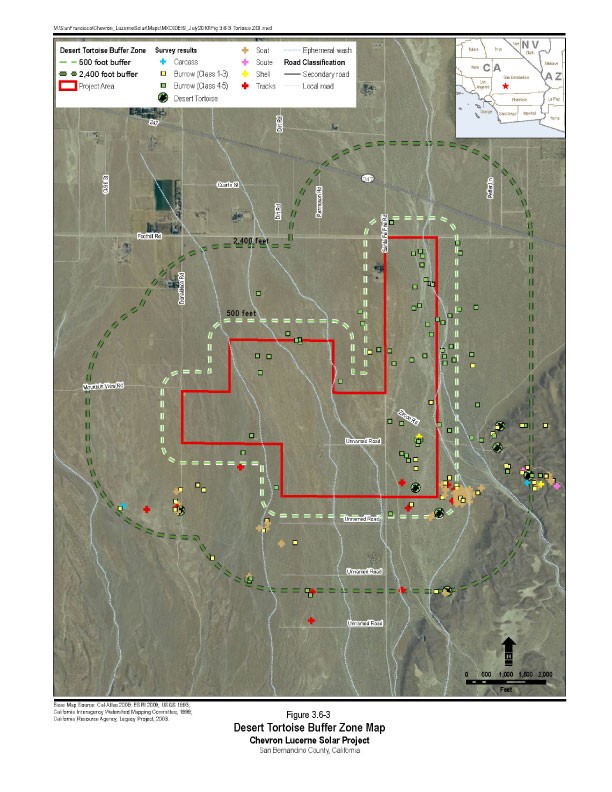
^A high density of tortoises and sign was found on the project site. Green squares are burrows.
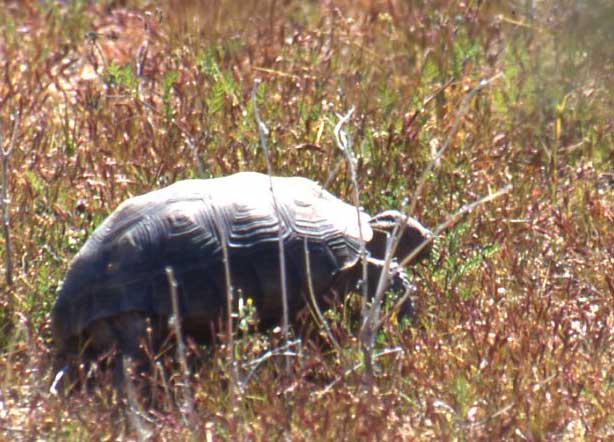
^Desert tortoise in spring.
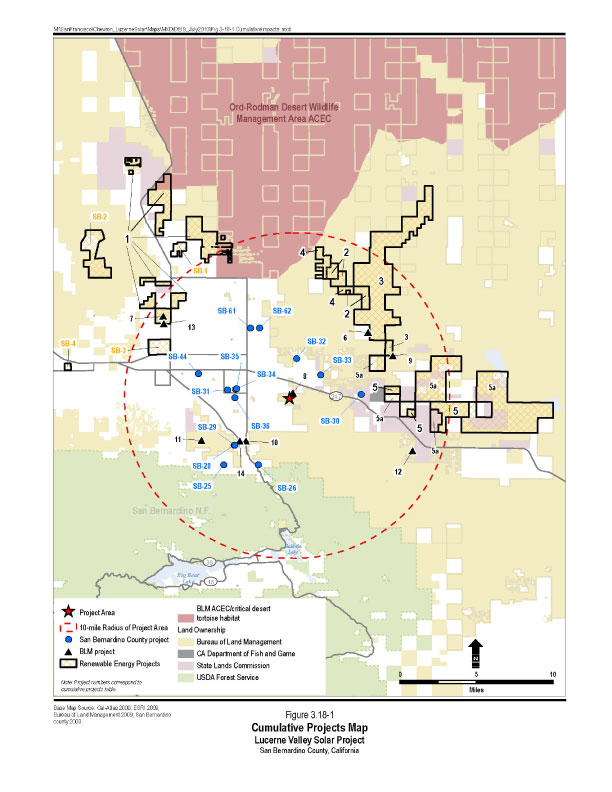
^Black outlines show more renewable energy projects planned. Piece by piece, bit by bit the desert will disappear.
